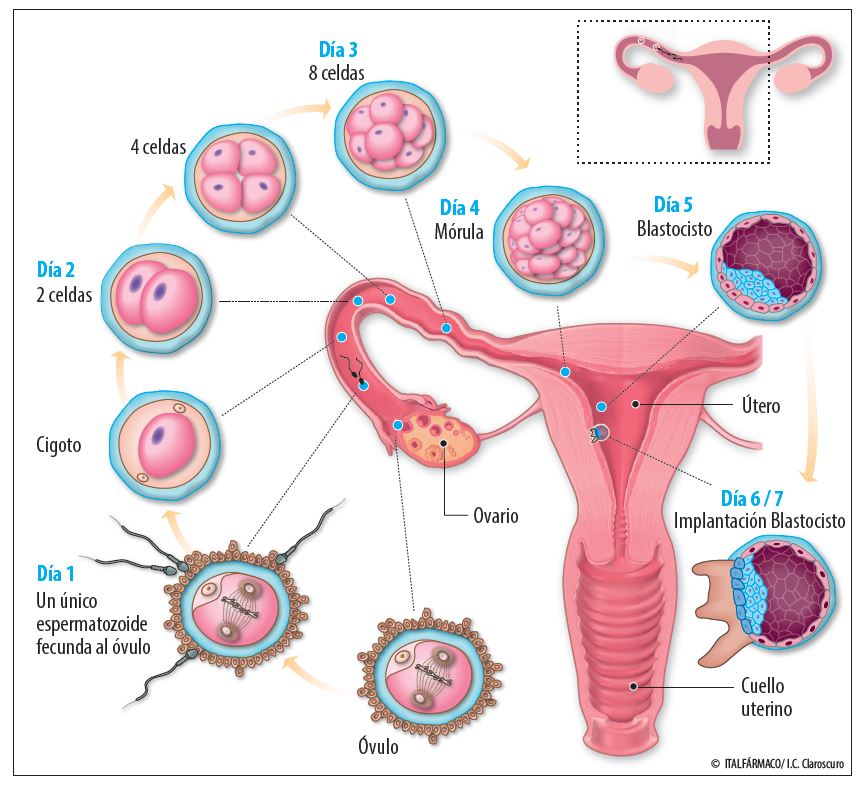Implantación embrionaria. Algunos aspectos moleculares en la receptividad endometrial. Revisión Bibliográfica
Palabras clave:
implantación del embrión, infertilidad, endometrio, biomarcadores.Resumen
La implantación embrionaria es un proceso que tiene lugar durante un breve periodo de tiempo donde el tejido endometrial alcanza un estado receptivo y donde se expresan moléculas que son necesarias para el proceso de implantación y posterior invasión del blastocisto. Este periodo se conoce como ventana de implantación y tiene lugar alrededor del día 20-21 del ciclo menstrual. El endometrio receptivo ha sido ampliamente estudiado desde el punto de vista histológico y molecular, y se conocen gran número de marcadores que forman parte de la firma molecular del endometrio receptivo, lo cual ha servido para desarrollar herramientas moleculares genómicas para el diagnóstico de la receptividad endometrial con utilidad clínica. Sin embargo, hasta ahora no se ha tenido en cuenta que la capacidad receptiva del endometrio tiene un componente inmunológico importante que facilita la entrada del tejido embrionario en el tejido materno. El objetivo de esta revisión es destacar ciertos grupos de biomarcadores identificados con un papel fundamental en el mecanismo de implantación.
Descargas
Citas
1. Devesa Rodríguez de la Rua M. Factores asociados a la falla de la implantación: factor embrionario en edad materna avanzada. [Tesis Doctoral]. Barcelona: Universidad autónoma de Barcelona; 2015. Disponible en: https://www.tdx.cat/handle/10803/384479
2. Obiala ER. Falla de implantación: madre o embrión. Reproducción 2018 enero; 9(1): 5-16.
3. Hernández-Valencia M, Valencia-Ortega J, Ríos-Castillo B, Cruz-Cruz PR, Vélez-Sánchez D. Elementos de la implantación y placentación, aspectos clínicos y moleculares. Reproducción 2014; 7: 102-116.
4. Fatemi HM, Popovic Todorovic B. Implantation in assisted reproduction: a look at endometrial receptivity. Reproductive BioMedicine Online 2013; 27(5): 530-538.
5. Makrigiannakis A, Minas V. Mechanisms of implantation. Reproductive BioMedicine Online 2007; 14(1): 102-109.
6. Minas V, Loutradis D, Makrigiannakis A. Factors controlingblastocist implantation. Reproductive BioMedicine Online 2005; 10(2): 205-216.
7. Emiliani S, Delbaere A, Devreker F, Englert Y. Embryo-Maternal interactive factos regulating the implantation process: implications in assisted reproductive treatment. Reproductive BioMedicine Online 2005; 10(4): 527-540.
8. Guzeloglu-Kayisli O, Basar M, Arici A. Basec aspects of implantation. Reproductive BioMedicine Online 2007; 15(6): 728-739.
9. García Martín S, Horcajadas Almansa JA. Desarrollo de una nueva herramienta diagnóstica para redefinir la firma molecular de la receptividad endometrial. Biosaia [Internet] 2014 [citado 22 de julio del 2018]; (3). Disponible en: https://www.upo.es/revistas/index.php/biosaia/article/view/912
10. Andreatta E, Elena AC, Distilo CR, Landi G, Machado CE, Pené AI, Pirrotta NA. Receptividad endometrial: La ecografía Doppler y la aplicación de sildenafil ofrecen mejores resultados en pacientes con fracasos en los tratamientos de fertilización in vitro. Resultados preliminares. Reproducción 2015; (30): 63-71.
11. García Enguídanos A. Utilidad de los biomaracdores de recpetividad endometrial. II Jornada de Actualización Científica. Transferencia Embrionaria. Disponible en: https://docplayer.es/43269518-Utilidad-de-los-biomarcadores-de-receptividad-endometrial.html
12. Pellicer A, Dominguez F, Remohi J, Simón C. Molecular basis of implantation. Reproductive BioMedicine Online 2002; 5(Suppl 1): 44-51.
13. Hoozemans D, Schats R, Lambalk C, Homburg R, Hompes PG. Human embryo implantation: current knowledge and clinical implications in assisted reproductive technology. Reproductive BioMedicine Online 2004; 9(6): 692-715.
14. Strowitzki T, Germeyer A, Popovici R, Wolff M. The human endometrium as a fertility-determinig factor. Human Reprod Update 2006; 12(5): 617-630.
15. Diedrich K, Fauser B, Devroey P, Griesinger G. The role of the endometrium and embryo in human implantation. Human Reprod Update 2007; 13(4): 365-377.
16. Cavagna M, Mantese J. Biomarkers of endometrial receptivity –A review.
Placenta 2003; 24(Suppl B): S39-S47.
17. Rashid N, Lalitkumar S, Lalitkumar P, Gemzell- Danielsson K. Endometrial receptivity and human embryo implantation. Am J Reprod Immunol 2011; 66(suppl. 1): 23-30.
18. Achache H, Revel A. Endometrial receptivity markers, the journey to successful embyo implantation. Human Reprod Update 2016; 12(6): 731-746.
19. Young S. Oestrogen and progesterone action on endometrium: a translational approach to understanding endoemtrial receptivity. Reproductive BioMedicine Online 2013; 27(5): 497-505.
20. Sharkey A, Smith S. The endometrium as a cause of implantation failure. Best Practice & Research Clinical Obstetrics & Gynaecology 2003; 17(2): 289-307.
21. Koot Y, Teklenburg G, Salker M, Brosens J, Macklon N. Molecular aspects of implantation failure. Biochim Biophys Acta 2012; 1822(12): 1943-1950.
22. Lindhard A, Betin-Ley U, Ravn V, Islin Hk, Hviid T, Rex S, Bangsboll S, Sorensen S. Biochemical evaluation of endometrial function at the time of implantation. Fertil Steril 2002; 78(2): 221-233.
23. Quinn C, Casper R. Pinopodes: a questionablerole in endometrial receptivity. Human Reprod Update 2009; 15(2): 229-236.
24. Lessey BA. Endometrial receptivity and the window of implantation. Baillieres Best Prac Rest Clin Obst Gynaecol 2000; 14(5): 775-788.
25. Von Grothusen C, Lalitkumar S, Boggavarapu N, Gemzell-Danielsson K, Lalitkumar P. Recent Advances in Understanding Endometrial Receptivity: Molecular Basis and Clinical Applications. Am J Reprod Immunol 2014; 72(2): 148-157.
26. Edgell T, Rombauts L, Salamonsen L. Assessing receptivity in the endometrium: the need for a rapid, non-invasive test. Reprod BioMed Online 2013; 27(5): 486-496.
27.Garrido-Gomez T, Ruiz-Alonso M, Blesa D, Diaz-Gimeno P; Villela F, Simon C. Profiling the gene signature of endometrial receptivity: clinical results. Fertil Steril 2013; 99(4): 1078-1085.
28. Horcajadas J, Riesewijk A, Martín J, Cervero A, Mosselman S, Pellicer A, Simón C. Global gene expression profiling of human endometrial receptivity. J Reprod Immunol 2004; 63(1): 41-49.
29. Diaz-Gimeno P, Horcajadas J, Martínez-Conejero J, Esteban F, Alamá P, Pellicer A, Simón C. A genomic diagnostic tool for human endometrial receptivity based on the transcriptomic signature. Fertil Steril 2011; 95(1): 50-60.

Descargas
Publicado
Cómo citar
Número
Sección
Licencia
Avisos de derechos de autor propuestos por Creative Commons
1. Política propuesta para revistas que ofrecen acceso abierto
Aquellos autores/as que tengan publicaciones con esta revista, aceptan los términos siguientes:- Los autores/as conservarán sus derechos de autor y garantizarán a la revista el derecho de primera publicación de su obra, el cuál estará simultáneamente sujeto a la Licencia de reconocimiento de Creative Commons que permite a terceros compartir la obra siempre que se indique su autor y su primera publicación esta revista.
- Los autores/as podrán adoptar otros acuerdos de licencia no exclusiva de distribución de la versión de la obra publicada (p. ej.: depositarla en un archivo telemático institucional o publicarla en un volumen monográfico) siempre que se indique la publicación inicial en esta revista.
- Se permite y recomienda a los autores/as difundir su obra a través de Internet (p. ej.: en archivos telemáticos institucionales o en su página web) antes y durante el proceso de envío, lo cual puede producir intercambios interesantes y aumentar las citas de la obra publicada. (Véase El efecto del acceso abierto).







